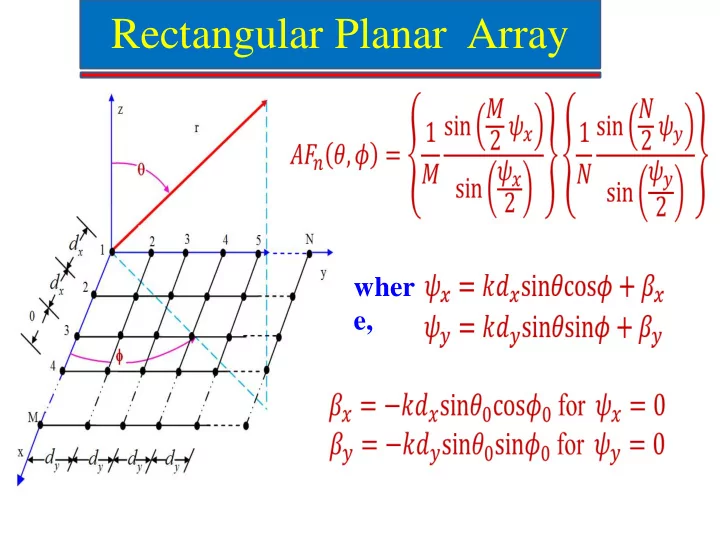

Rectangular Planar Array wher e,
Rectangular Planar Array an where k = 2 π / λ d The principal maximum(m = n = 0) and grating lobes can be located by: m = 0, 1, 2,…. n = 0, 1, 2,….
Radiation Pattern of 5x5 Planar Array
Directivity of Planar Array Directivity of Rectangular Array For Broadside Array: Directivity of Circular Array
Hexagonal Array – 7 Elements Example: Calculate the array factor of a 7-elements hexagonal array (2 elements in first and third rows, 3 elements in the second row). y Group 2- λ /2 2x2 array λ /2 x Group 1- 3x1 array Total Array Factor = Array Factor of (Group 1 + Group 2)
AF of Hexagonal Array – 7 Elements Array factor of Group 2: M = 3, N = 1 Array factor of Group 2: M = 2, N = 2 Total Array Factor = AF 1 + AF 2
Hexagonal Array – 19 Elements Example: Calculate the array factor of a 19-elements hexagonal array (3 elements in first and fifth rows, 4 elements in the y second and fourth rows and 5 in the third row) Group 3- 3x2 array Group 2- 4x2 λ /2 λ /2 array x Group 1- 5x1 array Total Array Factor = Array Factor of (Group 1 + Group 2 + Group 3)
AF of Hexagonal Array – 19 Elements Array Factor of Group 1: M=5, N=1 Array Factor of Group 2: M=4, N=2
AF of Hexagonal Array – 19 Elements (Contd.) Array Factor of Group 3: M=3, N=2 Total Array Factor:
Circular Vs Hexagonal Array Planar Circular Planar Hexagonal Array Array
Microstrip Antennas Prof. Girish Kumar Electrical Engineering Department, IIT Bombay gkumar@ee.iitb.ac.in (022) 2576 7436
Rectangular Microstrip Antenna (RMSA) Y Top X W View x L Side r h View Ground plane Co-axial feed
Microwave Integrated Circuits (MIC) vs MSA Parameters MIC MSA Dielectric Large Small Constant ( ε r ) Thickness (h) Small Large Width (W) Generally Small Generally Large (impedance dependent) Radiation Minimum (small fringing Maximum (large fields) fringing fields) Examples Filters, power dividers, Antennas couplers, amplifiers, etc.
Substrates for MSA Substrate Dielectric Loss tangent Cost Constant ( ε r ) (tan δ ) Alumina 9.8 0.001 Very High Glass Epoxy 4.4 0.02 Low Duroid / 2.2 0.0009 Very Arlon High Foam 1.05 0.0001 Low/ Medium Air 1 0 NA
Advantages Light weight, low volume, low profile, planar configuration, which can be made conformal Low fabrication cost and ease of mass production Linear and circular polarizations are possible Dual frequency antennas can be easily realized Feed lines and matching network can be easily integrated with antenna structure
Disadvantages Narrow bandwidth (1 to 5%) Low power handling capacity Practical limitation on Gain (around 30 dB) Poor isolation between the feed and radiating elements Excitation of surface waves Tolerance problem requires good quality substrate, which are expensive Polarization purity is difficult to achieve
Applications Pagers and mobile phones Doppler and other radars Satellite communication Radio altimeter Command guidance and telemetry in missiles Feed elements in complex antennas Satellite navigation receiver Biomedical radiator
Various Microstrip Antenna Shapes
MSA Feeding Techniques
Coaxial Feed
Microstrip Line Feed
Microstrip Feed (contd.)
Electromagnetically Coupled Feed
Aperture Coupled Feed
RMSA: Resonance Frequency x W e W L L e ~ where m and n are orthogonal modes of excitation. Fundamental mode is TM 10 mode, where m =1 and n = 0.
RMSA – Characterization
RMSA: Design Equations Smaller or larger W can be taken than the W obtained from this expression. BW α W and Gain α W Choose feed-point x between L /6 to L /4.
RMSA: Design Example Design a RMSA for Wi-Fi application (2.400 to 2.483 GHz) Chose Substrate: ε r = 2.32, h = 0.16 cm and tan δ = 0.001 = 3 x 10 10 / ( 2 x 2.4415 x 10 9 x √1.66) = 4.77 cm. W = 4.7 cm is taken = 2.23 = 3 x 10 10 / ( 2 x 2.4415 x 10 9 x √2.23) cm L e = 4.11 cm L = L e – 2 ∆L = 4.11 – 2 x 0.16 / √2.23 = 3.9 cm
RMSA: Design Example – Simulation using IE3D L = 3.9 cm, W = 4.7 cm, x = 0.7 cm ε r = 2.32, h = 0.16 cm and tan δ = 0.001 BW for |S11| < -10 dB is from Z in = 54 Ω at f = 2.414 GHz 2.395 to 2.435 GHz = 40 MHz Designed f = 2.4415 and Simulated f = 2.414 GHz % error = 1.1%. Also, BW is small. SOLUTION: Increase h and reduce L
Recommend
More recommend